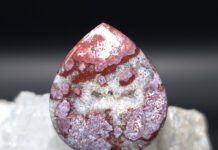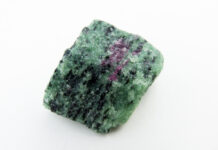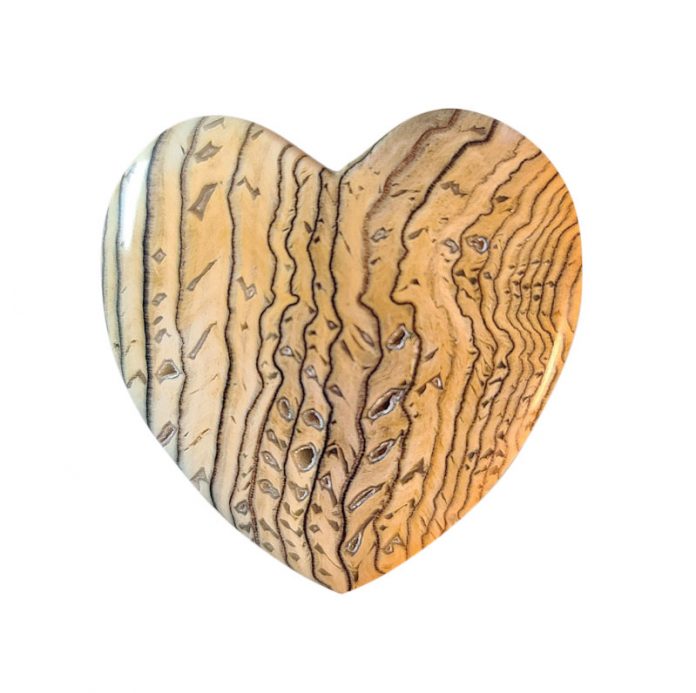
Hell’s Canyon petrified wood is elusive and has been one of the most popular petrified woods for decades. It was once collected along the Snake River, bordering Oregon and Idaho, until the Hell’s Canyon Dam construction. Now the entire collection site is underwater.
This was a unique find, and there has yet to be another like it since. Other popular petrified wood specimens include sycamore petrified wood and North Dakota’s teredo petrified wood. Hell’s Canyon Petrified Wood is known to be from the Cretaceous and Miocene era (25 to 145 million years ago). It displays beautiful wavy patterns, known as herringbone, which were the natural growth rings of the ancient Sequoia trees. It also contains dry rot holes that have since been filled with silica and micro drusy cavities.
How to Get Hell’s Canyon Petrified Wood
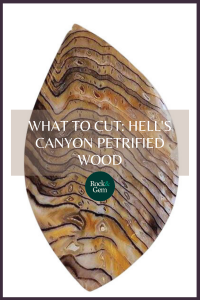
Hell’s Canyon Petrified Wood isn’t always the easiest of materials to find in the marketplace, but it still can be found in various places online and occasionally at shows. Most of what you find are slabs, and rarely do you see chunks of rough on offer. Not that buying slabs is a bad thing, it actually gives you a good view of exactly what you are buying. One thing to note when purchasing, the thicker the slabs, the better, as it tends to be quite brittle to cut and breaks easily. If you find thin slabs for sale, it’s not the end of the world; it just means you will need to back them before cabbing, which may be the best course of action in the first place, not risking breaking any of this rare and usually expensive material.
Prepping Slabs
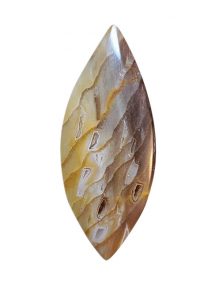 Prepping your slabs for preforms is really important since you don’t want to lose any portion of your material. I would generally suggest bench testing slabs to see if there are hidden fractures and if the material will break at an early stage in the cabbing process, but with this material, you should just assume it can break at any spot. To avoid risking the entire slab, I usually cut one preform out closest to the edge of the slab, and start my usual cabbing process, and see how it responds. If it can cab without any hazards, you’re good to go with the remaining portion of the slab. If it was too brittle and portions broke off, then you know to back the entire slab first before trimming out any further preforms.
Prepping your slabs for preforms is really important since you don’t want to lose any portion of your material. I would generally suggest bench testing slabs to see if there are hidden fractures and if the material will break at an early stage in the cabbing process, but with this material, you should just assume it can break at any spot. To avoid risking the entire slab, I usually cut one preform out closest to the edge of the slab, and start my usual cabbing process, and see how it responds. If it can cab without any hazards, you’re good to go with the remaining portion of the slab. If it was too brittle and portions broke off, then you know to back the entire slab first before trimming out any further preforms.
Backing your slabs is generally easy, as various epoxies can be used. Many people like to back their cabs with black basanite, or you can choose something that has the same general color combinations as what you are cabbing, possibly another type of petrified wood. Spread out a generous amount of epoxy around the edges of your slab, and fill the center as much as possible to avoid any air pockets. I like to use spring clamps to add pressure all around the glued areas, compressing and expanding the glue to the entire area, and allowing it to ooze out the edges. It’s better to use too much epoxy than not enough, and just tip the slab up at an angle to dry, allowing the excess glue to drip onto something that can be discarded.
Cabbing Hell’s Canyon Petrified Wood
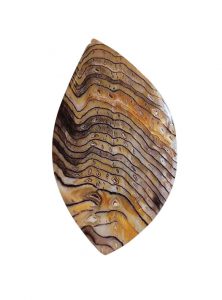 Cabbing this material is fairly easy. It just needs to be worked with a gentle touch. Starting with an 80 grit steel wheel may be too aggressive for this type of material, as it’s fairly soft, to begin with, and as stated, brittle. So I would suggest starting on a 220 grit steel wheel to shape and dome your cab. Be cautious not to get the dry rot holes too close to the edge, or you might possibly break open the holes, leaving an uneven edge. Once you have your preform cab shaped and domed, move on to the 280 grit soft resin wheel; from this point, you should be able to apply a generous amount of pressure and smooth your cab out, and check thoroughly for any remaining scratches. Once the scratches are completely gone, move to your 600 grit and continue as a usual jasper-type cab.
Cabbing this material is fairly easy. It just needs to be worked with a gentle touch. Starting with an 80 grit steel wheel may be too aggressive for this type of material, as it’s fairly soft, to begin with, and as stated, brittle. So I would suggest starting on a 220 grit steel wheel to shape and dome your cab. Be cautious not to get the dry rot holes too close to the edge, or you might possibly break open the holes, leaving an uneven edge. Once you have your preform cab shaped and domed, move on to the 280 grit soft resin wheel; from this point, you should be able to apply a generous amount of pressure and smooth your cab out, and check thoroughly for any remaining scratches. Once the scratches are completely gone, move to your 600 grit and continue as a usual jasper-type cab.
Once you’ve reached the 14k grit polishing wheel, this is probably as far as you need to go, as it takes a beautiful polish and the patterns will just pop. Trying to use polishing compounds might fill in the tiny dry rot vugs and create heat fractures from the friction of the polishing pads.
This What to Cut column about Hell’s Canyon petrified wood previously appeared in Rock & Gem magazine. Click here to subscribe! Story by Russ Kaniuth.



